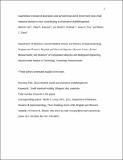| dc.contributor.author | Fox, James G. | |
| dc.contributor.author | Xie, Meimin | |
| dc.contributor.author | Kotecha, Vijay R. | |
| dc.contributor.author | Andrade, Jon David P. | |
| dc.contributor.author | Carey, Martin C. | |
| dc.date.accessioned | 2013-03-28T14:20:39Z | |
| dc.date.available | 2013-03-28T14:20:39Z | |
| dc.date.issued | 2012-02 | |
| dc.date.submitted | 2012-02 | |
| dc.identifier.issn | 0022-3751 | |
| dc.identifier.issn | 1469-7793 | |
| dc.identifier.uri | http://hdl.handle.net/1721.1/78010 | |
| dc.description.abstract | Cholesterol gallstones are associated with slow intestinal transit in humans as well as in animal models, but the molecular mechanism is unknown. We investigated in C57L/J mice whether the components of a lithogenic diet (LD; 1.0% cholesterol, 0.5% cholic acid and 17% triglycerides), as well as distal intestinal infection with Helicobacter hepaticus, influence small intestinal transit time. By quantifying the distribution of 3H-sitostanol along the length of the small intestine following intraduodenal instillation, we observed that, in both sexes, the geometric centre (dimensionless) was retarded significantly (P < 0.05) by LD but not slowed further by helicobacter infection (males, 9.4 ± 0.5 (uninfected), 9.6 ± 0.5 (infected) on LD compared with 12.5 ± 0.4 and 11.4 ± 0.5 on chow). The effect of the LD was reproduced only by the binary combination of cholesterol and cholic acid. We inferred that the LD-induced cholesterol enrichment of the sarcolemmae of intestinal smooth muscle cells produced hypomotility from signal-transduction decoupling of cholecystokinin (CCK), a physiological agonist for small intestinal propulsion in mice. Treatment with ezetimibe in an amount sufficient to block intestinal cholesterol absorption caused small intestinal transit time to return to normal. In most cholesterol gallstone-prone humans, lithogenic bile carries large quantities of hepatic cholesterol into the upper small intestine continuously, thereby reproducing this dietary effect in mice. Intestinal hypomotility promotes cholelithogenesis by augmenting formation of deoxycholate, a pro-lithogenic secondary bile salt, and increasing the fraction of intestinal cholesterol absorbed. | en_US |
| dc.description.sponsorship | National Institutes of Health (U.S.) (Grant R01CA067529) | en_US |
| dc.language.iso | en_US | |
| dc.publisher | Wiley Blackwell (Blackwell Publishing -The Physiological Society) | en_US |
| dc.relation.isversionof | http://dx.doi.org/10.1113/jphysiol.2011.224717 | en_US |
| dc.rights | Creative Commons Attribution-Noncommercial-Share Alike 3.0 | en_US |
| dc.rights.uri | http://creativecommons.org/licenses/by-nc-sa/3.0/ | en_US |
| dc.source | Prof. Fox via Howard Silver | en_US |
| dc.title | Augmented cholesterol absorption and sarcolemmal sterol enrichment slow small intestinal transit in mice, contributing to cholesterol cholelithogenesis | en_US |
| dc.type | Article | en_US |
| dc.identifier.citation | Xie, M. et al. “Augmented Cholesterol Absorption and Sarcolemmal Sterol Enrichment Slow Small Intestinal Transit in Mice, Contributing to Cholesterol Cholelithogenesis.” The Journal of Physiology 590.8 (2012): 1811–1824. | en_US |
| dc.contributor.department | Massachusetts Institute of Technology. Department of Biological Engineering | en_US |
| dc.contributor.department | Massachusetts Institute of Technology. Division of Comparative Medicine | en_US |
| dc.contributor.approver | Fox, James G. | |
| dc.contributor.mitauthor | Fox, James G. | |
| dc.relation.journal | The Journal of Physiology | en_US |
| dc.eprint.version | Author's final manuscript | en_US |
| dc.type.uri | http://purl.org/eprint/type/JournalArticle | en_US |
| eprint.status | http://purl.org/eprint/status/PeerReviewed | en_US |
| dspace.orderedauthors | Xie, M.; Kotecha, V. R.; Andrade, J. D. P.; Fox, J. G.; Carey, M. C. | en |
| dc.identifier.orcid | https://orcid.org/0000-0001-9307-6116 | |
| mit.license | OPEN_ACCESS_POLICY | en_US |
| mit.metadata.status | Complete | |
